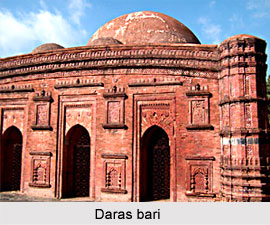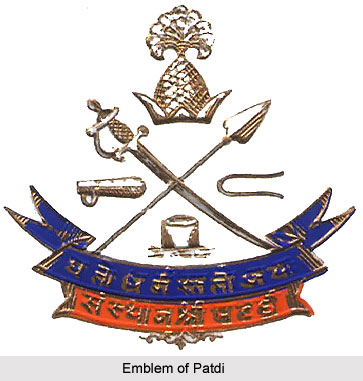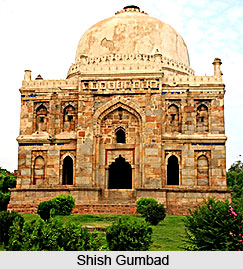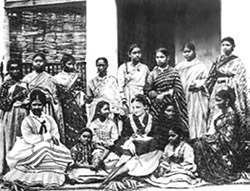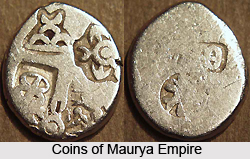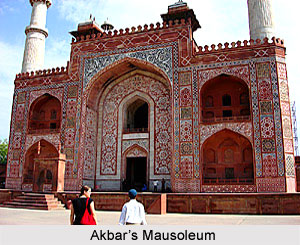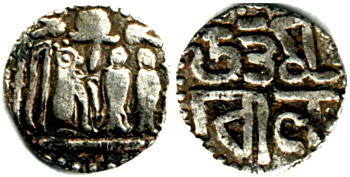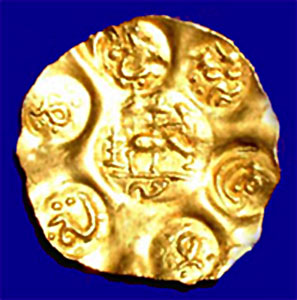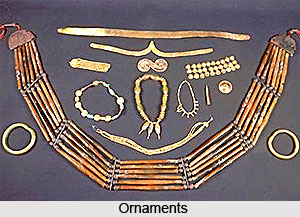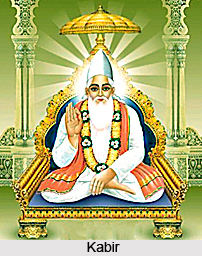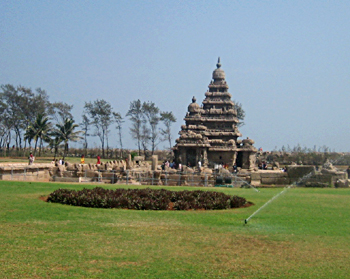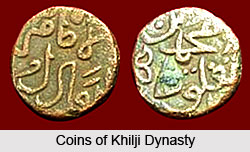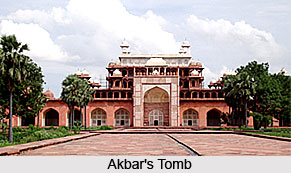 Upon the death of Akbar in 1605, Muhammad Sultan Salim had assumed the imperial throne. It is generally conceived that during Jahangir`s 22-year reign, half as long as Akbar`s, patronage for architecture had declined because of his much passion and keenness for painting. Time and again it is also stated that through common belief Jahangir`s influential wife, Nur Jahan, is credited as a principal `taste setter` of the time, with authentically stirring and perking the construction of buildings later during the emperor`s reign. Delhi, serving as the first base of Mughal Empire and its gradual dynastic spread, never did belittle in glory and splendour and respect, with Jahangir also not standing off the customary track. As such, just as with the dominance and overshadowing of the monumental proportions of Mughal architecture both during and after their presence, architecture in Delhi during Jahangir also cannot be denied, both with and without patronage and influence. Delhi`s architecture during Jahangir had in an unprecedented and unequalled manner, matched up to the exceedingly esteemed and honoured genre of Mughal architecture in Delhi.
Upon the death of Akbar in 1605, Muhammad Sultan Salim had assumed the imperial throne. It is generally conceived that during Jahangir`s 22-year reign, half as long as Akbar`s, patronage for architecture had declined because of his much passion and keenness for painting. Time and again it is also stated that through common belief Jahangir`s influential wife, Nur Jahan, is credited as a principal `taste setter` of the time, with authentically stirring and perking the construction of buildings later during the emperor`s reign. Delhi, serving as the first base of Mughal Empire and its gradual dynastic spread, never did belittle in glory and splendour and respect, with Jahangir also not standing off the customary track. As such, just as with the dominance and overshadowing of the monumental proportions of Mughal architecture both during and after their presence, architecture in Delhi during Jahangir also cannot be denied, both with and without patronage and influence. Delhi`s architecture during Jahangir had in an unprecedented and unequalled manner, matched up to the exceedingly esteemed and honoured genre of Mughal architecture in Delhi.
In fact, Jahangir in his memoirs refers more often to architecture in Delhi and elsewhere he had found pleasing or to buildings he had ordered than to paintings he had licensed and authorised officially, even though he is regarded as a great aficionado of painting. During Jahangir`s reign the realm is known to have been in a much secured position. Thus, the nobles and ranks of nobility were thoroughly boosted to prettify and beautify cities, build serais, gardens and dwellings and endow shrines - each and every one of then tangible manifestations of a prosperous state, thus truly strengthening the position of architecture of Delhi under Jahangir, which can be apprehended with minute details.
Delhi had remained a city of prime and superlative importance during Jahangir`s time and architecture there obviously tended to be innovative. Here, for instance, notables such as Shaikh Farid Bukhari built their own tombs; nearby Shaikh Fand Bukhari had established the town of Fandabad, providing a serai and mosque. Visits by the emperor to Delhi inevitably included hunting in the surrounds, attending to administrative concerns and visits to Humayun`s Tomb and the adjacent Chishti dargah of Nizam ud-Din. Architecture in Delhi during Jahangir`s time firstly included religious renovation in concern with Islam. The dargah of Nizam ud-Din was particularly revitalised through architectural patronage during the Mughal period. In it, the tomb of the legendary 14th century poet Amir Khusrau, had been embellished during the reigns of Babur, Humayun and Akbar. The tomb as it presently appears, however, was constructed in 1605-06 by Khwaja Tahir Muhammad Imad ud-Din Hasan during Jahangir`s reign. The Jahangiri period tomb is enclosed within a Humayun-period rectangular enclosure, framed of red sandstone latticed walls. It has been constructed of white marble lattice screen walls, continuing a tradition established during Akbar`s reign. There, within the tomb of Amir Khusrau, screens have been surmounted by a pyramidal vault. The white marble provides a subtle visual link between the poet, long revered as a saint, and Nizam ud-Din himself, also enshrined in a tomb of this material, brilliantly uplifting architectural works of Delhi in under Jahangir.
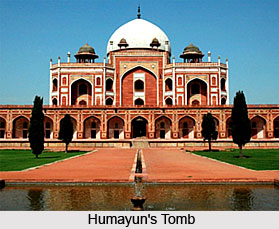 Nizam ud-Din`s own tomb, reconstructed during Akbar`s reign, was further embellished by Shaikh Farid Bukhari. In 1608-09, Shaikh Farid Bukhari had provided a canopy for the tomb`s interior, proving that imperially patronaged works were very much accepted by Jahangir and his architecture in Delhi. Constructed of wood exquisitely inlaid with mother-of-pearl, the canopy in Nizam ud-Din`s tomb is a rare instance of dated Mughal woodwork. Four bracketed pillars support the canopy`s vaulted roof, reflecting the inscription here that describes the sky as defended on four pillars. The inscription further states that the canopy was donated to honour the saint, but also to increase the honour of the builder. Concurrently with the provision of this canopy, Shaikh Farid Bukhari had erected the tomb of another Chishti saint, Wajih ud-Din, in Ahmedabad and several other religious instances in the eastern Indian city of Bihar Sharif.
Nizam ud-Din`s own tomb, reconstructed during Akbar`s reign, was further embellished by Shaikh Farid Bukhari. In 1608-09, Shaikh Farid Bukhari had provided a canopy for the tomb`s interior, proving that imperially patronaged works were very much accepted by Jahangir and his architecture in Delhi. Constructed of wood exquisitely inlaid with mother-of-pearl, the canopy in Nizam ud-Din`s tomb is a rare instance of dated Mughal woodwork. Four bracketed pillars support the canopy`s vaulted roof, reflecting the inscription here that describes the sky as defended on four pillars. The inscription further states that the canopy was donated to honour the saint, but also to increase the honour of the builder. Concurrently with the provision of this canopy, Shaikh Farid Bukhari had erected the tomb of another Chishti saint, Wajih ud-Din, in Ahmedabad and several other religious instances in the eastern Indian city of Bihar Sharif.
While these two structures in the dargah of Nizam ud-Din date to the initial period of Jahangir`s reign and his architecture in Delhi, the next monument, comprising a grave inscribed to 1623-24, belongs to his final years. This is the tomb of Mirza Aziz Koka Khan-i Azam, the son of Ataga Khan, Akbar`s prime minister. Ataga Khan had built the tomb of Mirza Aziz Koka Khan-i Azam, his own mausoleum, during his lifetime, but earlier, during Akbar`s reign, he had constructed a tomb for his father in this dargah. Mirza Aziz Koka obviously had favoured beautiful buildings. He is a classic instance of a sub-imperially patronaged man in relation to successful completion of architecture in Delhi during Jahangir. For instance, Mirza Aziz Koka`s house in the Agra Fort was painted by the head of Akbar`s painting atelier, Abd al-Samad and his tomb remains the finest Jahangir-period building in Delhi today.
Constructed wholly of white marble, the tomb of Mirza Aziz Koka is acknowledged popularly and respectably as the Chausath Khamba after the sixty-four pillars that divide it internally into twenty-five bays. Each bay is surmounted by a dome; nevertheless, externally the tomb appears flat-roofed. Each facade contains five arches supported by square pilasters. Between each pilaster is a screen, recalling those at the tomb of Sarkhej in Gujarat. The links with Sarkhej are not accidental though, for Mirza Aziz Koka had served several times as Jahangir`s governor of Gujarat. He had breathed his last there and was temporarily buried at Sarkhej. With the exception of the marble screens, the tomb bears very little ornamentation; its forms instead punctuated by uncluttered lines of the white marble surface serve as the main architectural idiom. Thus this tomb, perhaps, serves as a transition to the style associated with Shah Jahan`s period.
 Yet not all architectural work in Delhi during Jahangir reflects contemporary trends. Situated roughly between the dargah and Humayun`s Tomb is the tomb of Abdul-Rahim Khan-i Khanan. The Khan-i Khanan`s tomb is an enormous square domed structure that probably once stood in a four-quartered garden. This tomb was originally embellished with red sandstone and narrow strips of white marble trim, just like in Humayun`s Tomb. Most of the facing, however, was stripped during the 18th century and utilised on the tomb of Safdar Jang in south Delhi. The tomb appears remarkably conservative for a structure built at the time of the Khan-i Khanan`s death.
Yet not all architectural work in Delhi during Jahangir reflects contemporary trends. Situated roughly between the dargah and Humayun`s Tomb is the tomb of Abdul-Rahim Khan-i Khanan. The Khan-i Khanan`s tomb is an enormous square domed structure that probably once stood in a four-quartered garden. This tomb was originally embellished with red sandstone and narrow strips of white marble trim, just like in Humayun`s Tomb. Most of the facing, however, was stripped during the 18th century and utilised on the tomb of Safdar Jang in south Delhi. The tomb appears remarkably conservative for a structure built at the time of the Khan-i Khanan`s death.
The road from Delhi to Allahabad was also an architectural masterwork under Jahangir, which deserves mention in connection to Mughal architecture in and the outskirts of Delhi, so thoroughly accomplished by Jahangir. The road between Delhi and Agra was marked during Jahangir`s reign by kos minar, many of them still surviving. Along this road, the highest-ranking nobles had constructed magnificent serais - at Faridabad, Hodal, Palwal, Chatta and Mathura. This construction however was intended in part to protect their own investments; for instance, Maryam al-Zamani the queen mother (hugely admired as Jodhabai in present times, wife to Akbar and hence, mother of Jahangir), invested heavily in trade. It also responded to Jahangir`s accession order that serais be built, earning these nobles greater favour with the king, while at the same time serving as a manifestation of their own power and wealth.
Although most of these serais have disappeared in contemporary times, at least the entrance gate of one, at Chatta, approximately 60 km north of Agra, is well preserved. The red sandstone gate, flanked on either side by oriel windows, is entered through a deeply recessed arch. Although the gate is un-inscribed, the carved wine vessels and elaborate battlement that embellish it reflect current Mughal taste, ones which were heavily utilised in architecture in Delhi during Jahangir. Indeed, Jahangir`s periodic architecture of Delhi had overpowered so much that, Delhi`s outskirts were also influenced and chamed under such a man and his empire. And such current `Mughal-ish` dating under Jahangir is also supported by literary evidence.
Beyond Chatta lay the enigmatic and mysterious Agra, Jahangir`s paramount city, or for that matter every Mughal`s predominating city, then acknowledged as Akbarabad. Contemporary texts refer to the splendid structures built by the nobility there. Few of these remain, however, except the mosque of Mutamad Khan and two buildings recognised as the Kanch Mahal and the Suraj Bhan-ka Bagh, both constructed of red sandstone that bears elaborate carved ornament, attractions of latent architecture in Delhi and outskirts under Jahangir, which had almost reached Agra.


